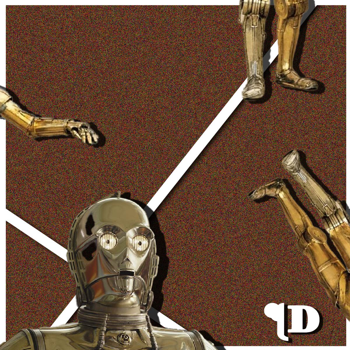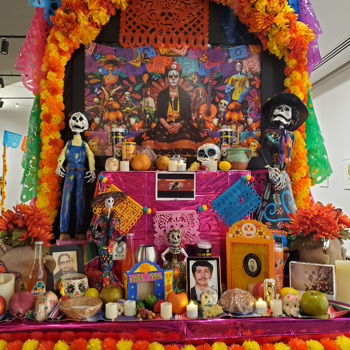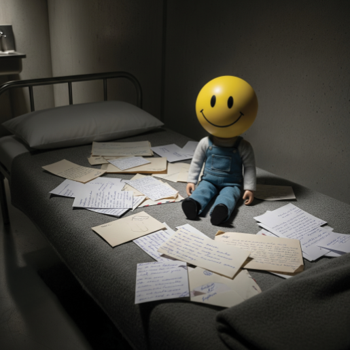Do I Dare to Eat a Peach?: An excerpt from the novel Petra
 Artwork by DALL·E
Artwork by DALL·E
Janice learned early in her journalism career–when she still had a career, or access to that grand ladder of opportunity to climb like a monkey clambering in its cage-–that each news story had its purpose. The coverage of crime, the civic enterprise, and the arcana of bureaucratic actions all had a place in the paper, under the guise of informing and educating citizens. Some stories served to preserve the public record or fulfilled journalism’s watchdog function. Others gave voice to the voiceless. And still others were meant to entertain on familiar subjects—local people, small children, exotic animals. Those were the stories that brought new readers in, kept the cash registers ringing, and the presses rolling.
At The Valley Times, where Janice was trying out for a job, all stories were supposed to center on people. Members of the community. Movers, shakers, and those who contributed in their small, though not insignificant ways. Cops. Teachers. Pediatricians. Volunteers, lots and lots of volunteers. Tales of woe, tales of triumph. The Valley Times was about readers recognizing themselves in the paper. That’s how a paper builds community, the managing editor told Janice.
“We want our readers to have a sense of ownership in the paper,” Harold Keller explained.
“That’s so important,” Janice allowed during the pre-try-out interview; or the next wrung of the ladder that she had to master, if she was to be awarded the opportunity to get to the actual try-out, which would lead to another wrung, and then another.
“Yes, ma’am,” her interlocuter agreed. “We try to hold a mirror up to the community.”
That community included her hometown, Sacramento, and the entire Central Valley: 450 miles of agri-business, migrant labor, and the great vat of people, places, and things harnessed to support that industry. From Bakersfield in the south to Chico in the north, The Valley Times was there every week to remind valley dwellers the California dream was more than hippies and Hollywood. Indeed, it had started in frontier towns and still thrived in rural centers. This was the true soul of California and its reaping, beating heart that The Valley Times was honor-bound to depict, and celebrate. The Valley Times chronicled the true promise of California, the hard work and ingenuity that made the state the nation’s best place to live.
“Of course,” Janice said, nodding. Was she nodding like an idiot? Most likely. “ ‘Who’ is the first of the five w’s,” Janice heard herself say. That aphorism was something she stole from another long-ago editor, whom she worked with before she got her big break at The Bulletin. The Bulletin was a major metropolitan daily on the east coast, a great leap forward on the monkey wrung that fizzled into nothing. When Janice was promoted to a local bureau at The Bulletin, she thought she was mere hops, skips, and jumps to the very tippy-top—to a foreign bureau, perhaps, that was so high she would not be able to see or feel those down below her. But that tippy top also can be precarious, and her upward trajectory reversed, fizzled into nothing, sending her plummeting back down to the bottom.
Others might bounce back from such a fall, but Janice had been wrecked by it, permanently injured. So much so she had to move across the country to recuperate, take up residency in her childhood bedroom. Her father thought The Valley Times was a suitable place to re-build, restore herself, and he had arranged the interview with the managing editor, a one-time ally in some good fights of the past. But now Keller was big on community, The Valley Times’ investment in the community, its focus on neighborhoods and neighbors, and the returns ordinary people expected from that investment.
Janice had rarely thought about the community, at least in the way Keller talked about it. The community had a mystical power, like an oracle that was both benevolent and self-correcting. The community that presumably read her stories in The Bulletin begged Janice to write about the quality of their water. Mud and sludge plopped out of their taps when they were expecting water, for some unknown reason. As Janice dug into the problem, pointed out the politicians and their functionaries who were responsible, that community turned on Janice. Her stories were bringing ruin to the city’s economy, sinking its property values, robbing people of their equity. Once she was fired—for insubordination, for continuing her reporting—those who had brought the story to her in the first place—said nothing. Last she heard, the community re-elected those same politicians who complained relentlessly to her editors about her, and by comfortable margins.
“If you want your readers to trust you, you’ve got to reflect their values,” Janice said to Keller’s satisfaction.
Janice dreaded the next question—whether she had any story ideas—not because she didn’t have any. But because she didn’t have any suitable for The Valley Times. Sacramento’s biggest hotel, its only luxury accommodation, at the center of a redevelopment plan financed with reams of taxpayer dollars, had gone bankrupt. Its debris were leaking over the pages of the city’s two dailies, but far too much mystery surrounded this denouement. Janice thought if she could wade through the court filings; if she could crawl into a hoard of documents; she’d find evidence of all the corrupt alliances, dubious arrangements and wretched conveniences that went into that project. Keller had no idea the hotel story was even relevant. Perhaps if the hotel was owned by the president of the PTA, he might be interested.
“I love finding stories in classrooms,” Janice said, because The Valley Times was more than about people, but the everyday interventions people make that better other people’s lives, Keller said. The man was an ancient, hulking specimen, a real Apeneck Sweeney, Janice thought, walking among those who had sold their souls to get a job, any kind of job, in journalism. He reminded Janice of the other editors she’d known, presiding over newsrooms of tribulation and disillusionment. But Keller was the man her father knew, the connection who had intervened on her behalf. She tried not to offend him outright or remind him of what everybody already knew about her—that she was damaged goods, difficult; someone who had rose a rising tide to a big job on a big paper and then came crashing down like a drunk gorilla.
“Not just public-school classrooms,” Janice said, “but community art classes, adult literacy classes, Voc-Ed classes, guest lecturers at community colleges.”
“I’ve got something for you then,” Keller said. He handed her a flyer for a school play. This would be her try-out assignment. Do I dare to each a peach, Janice thought.
What would you do if, while running away from your two cruel aunts, you landed in a gathering of enormous insects?
“I’d make friends with them real quick,” said Bethany Wilkerson, a 7-year-old second grader at Capitol Street School. With her classmates, Bethany appears in a dramatization of “James and the Giant Peach.” The premiere of Capitol Street’s production of the beloved children’s story by Roald Dahl is scheduled for next week.
Bethany wears a green t-shirt, green jeans and a pair of shimmering green sleeves of sequins to portray the grasshopper, who provides the crew of the giant peach with music during their perilous journey across the Atlantic. She was chosen for the part, her teacher Michelle Jonas said, because of her devotion to the color green.
“It’s my favorite color,” Bethany said proudly, “like trees and grass and leaves.” Bethany’s participation in the play is part of Capitol Street’s attempt to…….
Here is where Janice got stuck. An assignment a high school or college intern could do, but she found its one kernel of controversy. It was a habit she desperately needed to drop, if only this once. Janice watched the entire student production of “James and the Giant Peach” at Capitol Street School, dutifully recorded the names of all the children in it, and the names of their teachers. She took notes on the kinds of materials used to improvise the costumes and sets. She checked out a copy of the book from the library downtown, so she’d be up on the plot. She got everything down in her notebook and was ready to write the story until the school principal approached her.
How exactly, the principal wanted to know, would she refer to these students? He was concerned, he said, that something in the story might get back to them. And that would be discouraging.
"Like what?" Janice asked, because she had legitimate doubts any one of these kids—or their parents--were going to read The Valley Times, or any other printed material.
"We don't want them to know they're 'at risk' or 'special needs' students," the principal said.
"They don't know already?" Janice asked.
"They know and they don't," said the principal, who in another context might have been a worthy expert to quote on childhood education. But now he wanted to play semantics. “ 'At-risk' and 'special needs' have such negative connotations.”
“Then why did you come up with them?” Janice asked.
“That question does nothing to solve the problem,” he said.
"What should I call them, then?" Janice asked. She tried to sound genuine, cooperative, but she was disgusted. This was the part of the job that crushed the soul; this negotiation over reality, which was a negotiation over the language that would depict reality. Whatever the actual truth was rarely played a part in the discussion.
“Perhaps we can think of something together,” the principal said.
There was treacle in the man’s voice. He needed it, to accompany the huge load of condescension. He was making a threat, Janice knew. He’d have her job, her reputation, the jobs and reputations of everyone at The Valley Times. But Janice had nothing to lose. She knew what she was, and she knew the language for it: A disgraced former journalist. Possibly disgruntled. She was a failure, just like these students. They were dumb, slow, unreachable, their behavior out-of-line, even defiant, oppositional. Janice knew all the words. Sure, they’d been put in a play to buck up their egos. But they’d been asked to play vermin.
“I’ll have to talk to my editor,” Janice said.
“You do that,” the principal said.
She wasn’t going to talk to Keller, because the last thing he likely wanted was to officiate this kind of haggling, this quid pro quo, something for nothing. That was what he expected his reporters to do.
…….to inspire children who needed incentives beyond what school traditionally supplies….
This formulation was, in a strict sense, true, Janice thought, even if it crushed whatever was left of her virtue to put it that way. But as her mother said, bodies still need to eat long after the souls have been liquidated.
…….to inspire certain children who might otherwise fall through the cracks of a traditional……
The last time she had been through this, Janice was covering the school board in a small, suburban county, just before she was promoted to the beach cities bureau at The Bulletin. The parents were “galvanized,” as the saying went, by a case of child sexual abuse at a local pre-school. Having teachers report any signs of child abuse in their students to school officials was not enough. They wanted to open more avenues for reporting to make it easier for anyone, anywhere, to start an investigation. Whether this meant people were ready to deputize the lunch lady or the creepy custodian, no one could say. But when one of the PTA moms told her about a new policy in the works, Janice dutifully reported it—much to the PTA mom’s dismay. The mom was neither quoted nor mentioned. The superintendent was the story’s lead source. But the mom was convinced there were too many identifying details that forged a brightly lit path right back to her and her son, a sexual abuse victim. On top of that, Janice had misused words—nouns, verbs, prepositions, conjunctions, articles--stretching them far beyond their basic definitions and purposes.
…to provide certain students with practical incentives for coming to school each day….
Janice couldn’t remember the woman’s name. But how she dressed--that was indelible. In crisp white suits. She was concerned for more than her son, she said, but also for the community. It was a small community, and people talked. She talked to Janice, and thanks to her story, everyone now knew she had talked to Janice. Certainly, there was another way to say the school system was considering a new child abuse reporting policy, without having to put it that way. Certainly, Janice could figure it out.
When the 3 R’s can’t inspire children in the classroom…….
What Janice didn’t understand then, but could now, was that the woman was acting out a part. At times her voice dipped below its regular, soothing register and became conspiratorial, as if she was handing out state secrets. But it was only jargon she trafficked in, Janice came to realize, infinitesimal adjustments to codicils and conventions. Just like the Capitol Street School principal, though he wasn’t dressed as well. Yet he didn’t lack the gravitas that had Janice bending over herself backwards.
To fire the imaginations of children with art, drama, and music….
That woman, the mother, wore white suits that were starched with such a fury, they were more apparatus than fashion. She sunk into those white suits as if she were sewn into them. Not that her wardrobe was spectacularly tight or suggestive, but her body seemed secondary to the strength and power of the suit. It was meant to mark her as above the rest, untouched because she was untouchable. She did not get down in the dirt with the other moms, who were more than happy to be quoted in the newspaper. If she lifted her arms and held her breath, Janice thought, the wind would carry her up and away—like the giant peach. Another Flying Nun. The Flying Martyr.
The principal was a martyr too, though that was his job, to be dragged down and absorb the abuse and insults that came with a job that relatively low-wage and definitely low-influence.
……. to inspire children with art, drama, and music when reading, writing, and arithmetic fails to capture their imaginations.
Yet the most humiliating part of the entire Valley Times episode—going along with her fathers’ plan, the try-out, the linguistic contortions she was committing in public to get it—was yet to come. Once Keller said she passed the try-out, she had to find references. But who could she possibly call, given what happened at The Bulletin. No matter whom she asked, she’d have to explain to them how the mighty Janice Gallante had fallen. What happened on the illustrious east coast, well-reputed daily everyone wanted to work for, because it conferred such power and prestige, this keeper of the daily record.
She could supply the facts, but to other people, they were just details. Some of those details might have already been familiar. Perhaps her former bosses at the small and mid-size dailies where she had worked her way up had heard a rumor or skimmed a brief in the Columbia Journalism Review. Whatever they knew, it hadn’t wholly made sense, but who had the time to get into these things. Special sections, investigative projects, feeding the beast every day—people had their own problems. And if they listened long enough to her story, what could they do but offer comments, condolences, or commiseration, an account of how they also lost their innocence in the business, or some other regrettable anecdote about an acquaintance or mutual friend in similar circumstances. Then they’d have to get off the phone pronto. The handset would become a burning thing in their hand. Something that consumed skin and connecting tissue. They had another call, their child needed to be picked up at school. Because in fact they wanted nothing to do with Janice or any other unfortunate comrade. Failure was contagious.
She could call the last editor she had at The Bulletin. The one who fought for her copy, consoled her with dinners, tried his level best to keep her on the staff. The main advantage of calling Peter Hale for a reference was that she knew when not to call. The Bulletin’s schedule lived on in her instincts, like muscle memory. When reporters and editors filed in. When they’d trickle out. The 9:30 a.m. meeting, the brief noon meeting, the 3:30 p.m. meeting. When he’d be at lunch, when he’d be back. She was three hours behind all that, being in California, but it felt as though she was always trying to catch up.
She called him at 6 a.m. her time, because she didn’t want to leave it to chance, or leave him a message. She wasn’t letting anyone else in that newsroom get the slightest hint of where she was, and what she was doing. Hale was dependable, but that was the problem. He’d give her a great reference.
“The Valley Times,” Hale repeated, once she described the situation. “Is that what you really want?”





